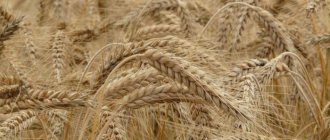In infancy, babies receive everything they need for their health through mother's milk, but after reaching a certain age, their body needs additional nutrition to strengthen the immune system. Of course, there are cases when the baby eats artificial formulas, the choice of which should be in favor of the best quality.
Parents should carefully monitor the baby’s nutrition, especially up to 1 year, since it is during this period of time that the child receives everything he needs for normal mental and physical development.
Nowadays, more and more mothers are concerned about gluten
in baby food
.
So, what is gluten and is it dangerous for your little one’s health?
Gluten is a protein that is present in all cereals, especially barley, wheat, rye, etc.
And because it sticks proteins together, gluten and gluten are the same thing. It is added to dairy products, semi-finished products and bakery products. It is logical to assume that gluten can be found in almost all products - it increases the shelf life of the product.
Why
gluten harmful for children?
The body of an adult can “cope” with this substance, which in some sense is even useful for a mature person.
But for babies aged 7-8 months, whose gastrointestinal tract is not yet fully developed, gluten can have a negative effect in the form of slow and difficult digestion. The child may begin to have problems digesting food and bowel function.
What types of gluten-free porridges are there?
The introduction of cereals into a child’s diet begins at the age of 6 months. The baby should try gluten-free ones cooked in water first. Doctors advise postponing the consumption of milk and dairy products until the baby is 10 months old.
The most suitable gluten-free cereals for complementary feeding are:
- Buckwheat. It very rarely causes an allergic reaction, is nutritious, promotes normal digestion, rich in potassium, magnesium, iron, phosphorus, B vitamins. This cereal contains a minimal amount of starch, so the baby’s body copes well with the digestion and assimilation of this product.
- Rice. Made without milk, this product is also hypoallergenic. Pediatricians recommend introducing it as complementary foods at 7-8 months. Rice is useful for activating brain activity and strengthening the child’s nervous system. Eating rice cereal helps cleanse the body of salts and toxins. But in some cases, this product should be treated with caution: with diabetes, regular constipation, excess weight.
- Corn. Like rice cereal, it contains a large amount of starch. However, it is easily absorbed during heat treatment. The product is low in calories. The risk of developing allergies when consuming it is minimal. And the benefits that corn porridge brings to a child’s body are invaluable: digestive problems and constipation are eliminated, blood vessels and muscle tissue are strengthened. Pediatricians advise offering dairy-free corn porridge to babies no more than 2 times a week.
Harm of gluten
Despite the benefits of gluten, experts warn against its use, since once it enters the human body it can trigger the development of the disease – celiac disease. It sounds scary, but there are also deaths among infants who have become victims of destruction of the stomach and intestines by gluten.
The sad moments presented occur due to the presence in children of a congenital genetic predisposition to gluten intolerance.
Celiac disease - gluten intolerance - can occur not only in children, but also in adults. As a rule, the predisposition of the gastrointestinal tract to such destruction is not diagnosed in advance. In the absence of timely treatment, there is a high probability of death.
On the other hand, patients with gluten intolerance account for only 1% of all humanity on the planet. It’s up to the baby’s parents to decide whether to take risks or be careful. But if an allergic reaction develops, you should immediately consult a doctor.
Which one to choose for the first complementary feeding?
The first porridge that a baby is introduced to should be dairy-free, single-ingredient, that is, consisting of one type of grain, and gluten-free.
Important: many pediatricians call buckwheat the most preferable choice for a baby’s first acquaintance with “adult” food.
Another pressing question for most mothers is whether to buy a ready-made product in a package or cook it yourself. There is no single correct answer. Each option has its pros and cons.
https://youtu.be/8VgtiDCGPxQ
Advantages of home-cooked and ready-made porridges:
| Welded houses | Ready |
| They are prepared from whole grains, which bring maximum benefits to the children's body. | Contains additional vitamin and mineral supplements. |
| They are superior in taste to ready-made ones. | Makes the cooking process as simple and fast as possible, which is important for many mothers who don’t have free time. |
| They activate the development of the skill of chewing food, as adults can gradually make the grind larger. | Large selection of manufacturers and products. |
Flaws:
| Welded houses | Ready |
| Grinding and cooking take a long time, and also require the use of a blender or coffee grinder, which may not always be at hand. | High price. |
| Not all grains have a stable composition. | Risk of purchasing a counterfeit. |
| If the cooking rules are violated, the dish loses all its beneficial properties. | Possibility of adding synthetic additives to the product, which may cause allergies. |
The correct answer to the question of which gluten-free porridge to choose for complementary feeding lies in the golden mean, and the most optimal choice is a combination of products sold ready-made and cooked on your own. In addition, parents should take into account the preferences of their children: some prefer homemade cereals, others prefer store-bought ones.
Consequences of use
Now it is necessary to talk about the already mentioned disease - celiac disease. Parents should fully study the issue presented, and most importantly, pay attention to the possible symptoms of the disease, which should help in a critical situation, because this disease can develop rapidly.
Celiac disease is a chronic disease characterized by hereditary or acquired intolerance to gluten. As a rule, the consequences of such a disease can be sad.
But in case of timely recognition of the problem and proper treatment, you can not only protect the baby from imminent death, but also significantly prevent the extent of its manifestation in the baby’s later life.
So, celiac disease is the lack of absorption of nutrients and microelements entering the body with food by the intestinal walls. So, the presented lesion manifests itself as follows:
- baby is not gaining weight
- there is a slow growth rate
- lethargy and hot temper can quickly and abruptly replace each other
- development of rickets, which is explained by calcium deficiency due to its inability to absorb
- delay in teething or caries damage to existing teeth
- swelling of the limbs
- bloating
But the presented symptoms appear gradually with the development of the disease. Parents must act immediately, so they should be alert to symptoms such as bloating and pain.
The baby begins to be capricious, which indicates abdominal pain. Moreover, his stomach begins to increase in size, inappropriate for normal intestinal bloating.
Distinctive signs of the development of celiac disease are changes in the consistency of stool and their unbearable odor. At first, the baby's diapers are difficult to wash due to the presence of fat in the feces.
Gradually, normal stools become light in color and foamy. These signs should alert parents. Here you need to urgently consult a doctor for help.
Introducing porridge into a baby's diet
The age at which a child can start feeding cereals is 6 months. When deciding whether this product can be given to your baby, you need to consider that:
- Vegetable purees are usually used as the first complementary food; they are given from 5 months, and only after a month can the baby eat cereals;
- for children with low body weight, with intestinal disorders, pediatricians recommend porridge as the first “adult” dish;
- If the child is large and overweight, then introduction to cereals is often postponed for 1-2 months.
It is good to start complementary feeding with gluten-free, dairy-free buckwheat porridge. For the first time, it is enough to give the child one teaspoon.
Then the portion can be increased little by little, so that after a week it is 150 grams.
After getting acquainted with buckwheat, you can move on to rice and corn cereals. And only after 2 months is it permissible to replace low-allergenic gluten-free cereals with foods containing gluten. During this period, it is necessary to carefully monitor the child’s well-being.
How to cook gluten-free porridge
To cook porridge for your baby yourself, you need to take gluten-free cereal and grind it using a coffee grinder. Then slowly pour it into a bowl of boiling water. To prevent lumps from appearing, you must stir constantly. After 15-20 minutes of cooking over low heat, you can remove the dishes and leave the porridge covered for another 10 minutes. For taste, you can add 2-3 drops of vegetable oil.
Important! You should not add salt or sugar to the dish; they do not benefit young children.
For babies under one year old, the norm for sugar consumption is 20-25 grams per day. And starting from 7-8 months, you can diversify the taste of porridge with the help of fruits.
Useful tips
When feeding a baby, parents need to consider that:
- Not only cereals with gluten are not suitable for first feeding, but also porridges containing flour, oat or wheat infusion;
- It’s worth holding off on eating porridges made from several types of grains;
- if the product contains cookies, then it is prohibited, since in the manufacture of cookies, wheat flour containing gluten is usually used;
- When buying ready-made gluten-free cereals for your child, it is better to give preference to products with added calcium and vitamin D.
Gluten-containing products
Products containing gluten can be divided into two categories:
- Products containing gluten
- Foods that may contain gluten (in some cases)
Contain gluten
The following food groups contain gluten:
- All types of wheat, including spelled, kamut, triticale (hybrid of wheat and rye), durum (durum wheat), einkorn, Farina, semolina, cake flour, matzo and couscous. Wheat is found in many types of bread, cakes, pretzels, cookies, crackers, pretzels, pasta, pizza, baked goods. In addition to these products, wheat may also appear in other products. Read food labels to make sure a product does not contain wheat flour.
- Most ingredients containing wheat: hydrolyzed wheat protein and pregelatinized wheat protein.
- Barley and malt, which is usually made from barley, including malt syrup, malt extract, malt flavoring and malt vinegar.
- Rye, which is most often found in baked goods. It is generally not used for the production of ingredients.
- Breaded (or with the addition of wheat flour) meats, poultry, seafood and vegetables. Or flavored with a sauce or marinade containing gluten, such as soy sauce or teriyaki sauce.
- Foods fried in the same oil as breaded foods are considered unsafe for people on a gluten-free diet.
On the subject: Gluten-free diet for autism: can it help?
Products containing any type of wheat, barley and rye contain gluten
May contain gluten
The following food groups may contain gluten and should be avoided.
- Beer is gluten-free only if it is made from gluten-free grains. Beer made from barley from which the gluten has been removed is not considered gluten-free.
- Dextrin may be made from wheat, which will be noted on the product label. Dextrin made from wheat contains gluten. If dextrin is obtained from potato or corn starch, then it does not contain gluten.
- Flavors are generally gluten-free, but in rare cases may contain wheat or barley.
- Modified food starch does not contain gluten unless it is made from wheat. Manufacturers are required to indicate on the packaging of their products that the product contains modified wheat starch or the packaging must indicate that the product contains wheat. However, not all manufacturers indicate the full composition of the product, which can lead to buyer misinformation.
- Wheat starch is considered a gluten-free product if the gluten protein has been previously removed from it, which should be stated on the product packaging. Wheat starch in foods that are not labeled gluten-free is not safe for people on a gluten-free diet.
- Rolled oats are considered safe for people on a gluten-free diet only if they have been specially processed to prevent cross-contamination with gluten-containing grains. Packages of such oat flakes must be labeled “Gluten Free.” If there is no such inscription on the package, then you are looking at ordinary oatmeal. Oats can be found in granola, granola bars, cookies and other foods. Products that contain oats but are not labeled “gluten-free” contain gluten.
- Medicines may contain gluten, although most do not contain this protein. Carefully read the ingredients of any drug prescribed for you before taking it, especially if you need to take it on an ongoing basis.
- Processed cheese may contain gluten. Only natural cheeses do not contain gluten.
- Seasonings and spice mixtures may contain gluten.
- Soy sauce typically contains wheat. Only wheat-free soy sauce is gluten-free. Look for soy sauce labeled gluten-free.
- The caramel color of foods is almost always due to the addition of corn, but may be due to the addition of malt syrup, making caramel-colored foods more likely to contain gluten.
A gluten-free diet can significantly improve the symptoms of various autoimmune diseases associated with gluten intolerance and celiac disease. Completely avoiding gluten-containing foods on an ongoing basis will allow you to breathe a sigh of relief as the symptoms of your disease will be minimized.











